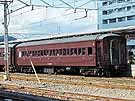
Suhafu-32 2357 at the rear end of the Paleo Express behind C58 363, at Yorii station. The tapered car body and squeezed round roof at the car end were typical features of old coaches before the war

Suhafu-32 2357 at the rear end of the Paleo Express behind C58 363, at Yorii station. The tapered car body and squeezed round roof at the car end were typical features of old coaches before the war
|
By Hiroshi Naito
The Suhafu-32, one of the last remaining old pre-war type coaches, made
the last run on the Chichibu Railway on October 25th, being hauled by
steam engine C58 363 together with three other ex-JNR coaches. The
Chichibu Railway was operating its weekend steam excursion train (Paleo
Express) with old JNR coaches leased from JR Takasaki depot, known for
steam engine D51 498 along with other old passenger cars preserved in
working order. However, it has purchased some modern class 12 coaches
for the Paleo Express operations from this year (2000), so old coaches
from the JNR will be no longer seen on this railway. The Suhafu-32 is
the oldest car among the Takasaki depot's preserved fleet of old JNR
coaches.
The Suhafu-32, numbered 2357, was built in 1938 as a class Suha 32
third class coach having a conductor cabin ("fu" signifies conductor
cabin). This class was the first 20m coach developed by the JNR. The
class was innovative with various features; new axle-coil suspended
TR23 trucks (bogies), air pressure applied water supply system with a
water tank suspended below the car flame, increased passenger seating
capacity of 88 from 80, etc. The most distinctive feature on the
exterior was narrow windows tidily arranged and corresponding to each
row of passenger seats. Also welding started to be used for car body
assembly from production of this class , finally eliminating riveting
from car body assembly around 1935. The earlier versions of this class,
with the first batch produced in 1929, still featured double roofs on
top, inherited from the previous passenger car design practice, and the
seat backs were bare wood. The Suhafu-32 2357 was a later version of
the class, comprising a rivet-less body and a fully rounded roof. The
interior furnishing was improved so that the backs of the passenger
seats were fully covered with velvet.
The class Suha-32 coaches were the most common third class passenger
cars for regular service before the EMU days, from the late 30s through
the 50s, along with Oha-35s fitted with widened windows but with the
same level of accommodation as Suha-32's. After the war, improved third
class coaches, e.g. class Suha-42 and Suha-43, were developed, but they
were mostly used for express services, and class Suha-32s still served
third class passengers in regular service on the main lines. In the
Tokyo area on the Tokaido Main Line, before the green-orange liveried
series 80 Shonan Densha (EMU) became common, Suha-32s were busily
carrying commuter passengers to Tokyo from the Shonan area, stretching
along the sea side southwest of Tokyo.
Since the Chichibu Railway ceased operations of old coaches, now the
Oigawa Railway is the only place where old coaches are seen in regular
service with steam operation.